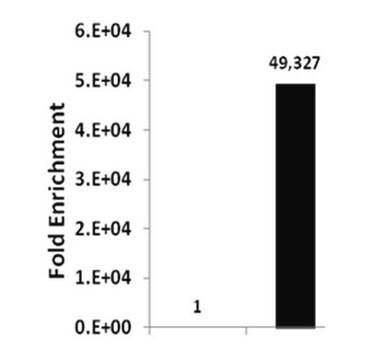17-10136
ChIPAb+ Dimethyl-Histone H3 (Lys36) - ChIP Validated Antibody and Primer Set
serum, from rabbit
Synonym(s):
H3K36me2, Histone H3 (dimethyl K36), H3 histone family, member T, Histone 3, H3, Histone cluster 3, H3
About This Item
Recommended Products
biological source
rabbit
Quality Level
antibody form
serum
clone
polyclonal
species reactivity
vertebrates, human
manufacturer/tradename
ChIPAb+
Upstate®
technique(s)
ChIP: suitable
electrophoretic mobility shift assay: suitable
immunoprecipitation (IP): suitable
western blot: suitable
NCBI accession no.
UniProt accession no.
shipped in
dry ice
General description
The ChIPAb+ Dimethyl Histone H3 (Lys36) set includes a Dimethyl Histone H3 (Lys36) antibody, a Normal Rabbit Serum, and positive control primers which amplify a 87 bp region of the human GAPDH coding region. The Dimethyl Histone H3 (Lys36) antibody and negative controls are supplied in a scalable "per ChIP" reaction size and can be used to functionally validate the precipitation of dimethyl Histone H3 (Lys36) associated chromatin.
Specificity
Immunogen
Application
Sonicated chromatin prepared from HeLa cells (1e5 cell equivalents per IP) were subjected to chromatin immunoprecipitation using 1 µL of either Normal Rabbit Serum (Part No. CS200585), or 1 µL Anti-Dimethyl Histone H3 (Lys36) (Part No.CS207357) and the Magna ChIP HiSens (Cat. # 17-10460). Successful immunoprecipitation of dimethyl Histone H3 (Lys36) associated DNA fragments was verified by qPCR using ChIP Primers, GAPDH coding D2 (Part No. CS207323) as a positive locus, and GAPDH promoter (Part No. 22-004) as a negative locus. (Figure 2). Data are presented as percent input of each IP sample relative to input chromatin for each amplicon and ChIP sample as indicated.
Please refer to the Magna ChIP HiSens (Cat. # 17-10460) or EZ-MagnaChIP HiSens(Cat. # 17-10461) protocol for experimental details.
Chromatin Immunoprecipitation:
Sonicated chromatin prepared from HeLa cells (1e5 cell equivalents per IP) were subjected to chromatin immunoprecipitation using 1 µL of either Normal Rabbit Serum (Part No. CS200585), or 1 µL Anti-Dimethyl Histone H3 (Lys36) (Part No.CS207357) and the Magna ChIP HiSens (Cat. # 17-10460). Successful immunoprecipitation of dimethyl Histone H3 (Lys36) associated DNA fragments was verified by qPCR using ChIP Primers, GAPDH coding D2 (Part No. CS207323) as a positive locus, and GAPDH promoter (Part No. 22-004) as a negative locus. Please refer to the Magna ChIP HiSens (Cat. # 17-10460) or EZ-MagnaChIP HiSens(Cat. # 17-10461) protocol for experimental details.
Western Blotting Analysis:
A 1:10,000 dilution of this antibody detected dimethyl Histone H3 (Lys36) in 10 µg HeLa acid extract and demonstrated a loss of signal in 0.5 µg of unmethylated recombinant Histone H3
Dot Blot Analysis: Representative lot data.
Absurance Histone H3 Antibody Specificity Array (Cat. No. 16-667, Fig. A) Absurance Histone H2A, H2B, and H4 Antibody Specificity Array (Cat. No. 16-665, Fig. B) were probed with Anti-Dimethyl Histone H3 (Lys36) (1:10,000 dilution). Proteins were visualized using a Donkey Anti-Rabbit IgG secondary antibody conjugated to HRP and a chemiluminescence detection system.
Epigenetics & Nuclear Function
Histones
Packaging
Quality
Please refer to the Magna ChIP HiSens (Cat. # 17-10460) or EZ-Magna ChIP HiSens (Cat. # 17-10461) protocol for experimental details.
Target description
Physical form
Normal Rabbit Serum, Part No. CS200585. One vial containing 25 µL antiserum containing 0.05% sodium azide. Store at -20°C.
ChIP Primers, GAPDH coding D2. Part No. CS207323. One vial containing 75 μL of 5 μM of each primer specific for human GAPDH coding region. (chr12:6647453+6647539, hg 19 build) Store at -20°C.
FOR: 5’ GCC ATG TAG ACC CCT TGA AGA GC 3’
REV: 5’ ACT GGT TGA GCA CAG GGT ACT TTA T 3’
Storage and Stability
Analysis Note
Includes normal rabbit serum and primers specific for human GAPDH, coding region.
Legal Information
Disclaimer
Storage Class
10 - Combustible liquids
Certificates of Analysis (COA)
Search for Certificates of Analysis (COA) by entering the products Lot/Batch Number. Lot and Batch Numbers can be found on a product’s label following the words ‘Lot’ or ‘Batch’.
Already Own This Product?
Find documentation for the products that you have recently purchased in the Document Library.
Our team of scientists has experience in all areas of research including Life Science, Material Science, Chemical Synthesis, Chromatography, Analytical and many others.
Contact Technical Service








